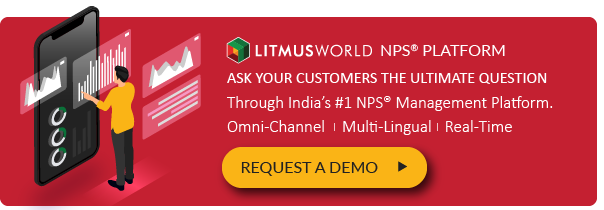The Ultimate Guide to the Net Promoter Score® (NPS): Expert Level
Everything You Need To Know About NPS®! (Level Expert)

8 minute read
The Ultimate Guide to the Net Promoter Score® is designed for all (Beginner, Intermediate, Proficient and Expert) levels of NPS® practitioners. The aim of this guide is to consolidate everything you need to know about the Net Promoter Score/Net Promoter System® on a single platform.
This guide encompasses everything from understanding to implementation to the success of NPS® initiatives. The guide is divided into 4 parts to make it easier for you to come back and continue reading from where you left-off. You are currently reading the ‘Level: Expert’ guide to NPS®.
At the end of the 4-part guide is a quiz that you can take to test your knowledge and learnings from this guide. Happy upskilling!
Before we begin, here is a quick disclaimer about the Net Promoter Score/System®:
Net Promoter, Net Promoter Score and NPS® are registered trademarks of Bain & Company, Inc., Fred Reichheld and Satmetrix Systems, Inc. All titles, content, publisher names, trademarks, artwork, and associated imagery are trademarks and/or copyright material of their respective owners.
With that said, let’s begin our journey towards dramatic improvements!
In this section:
- Should I link Front-Line KPIs with NPS® scores?
- How to prioritise CX improvement action items?
- How do I benchmark my NPS® scores against my competitors/industry average?
- What is NPS® 2.0?
- Test my NPS® understanding
Q16. Should I link Front-Line KPIs with NPS® scores?

There is no right or wrong answer to this question. It totally depends on the business objective and the current problem at hand.
5 reasons why you should link NPS® to front-line incentives:
- It drives front-line accountability to deliver customer excellence. Employees at all levels take customer satisfaction more seriously when they are motivated by monetary benefits.
- Sends a message to employees that customer loyalty matters. It demonstrates the seriousness of the company and is not just saying the words in a mission statement.
- Employees follow-up with customers faster and close-loop on issues on priority.
- Measures customer perceptions in a meaningful way and everyone contributes to it. NPS® is good for benchmarking purposes too.
- Creates a customer-obsessed culture. It’s a proven tactic.
And, 5 reasons why you should NOT link NPS® to front-line incentives:
- Employee Satisfaction gets priority over Customer Satisfaction. If employees are happy and loyal, customer satisfaction will inevitably follow.
- Data can be influenced. Employees learn to create the numbers and beg for high scores, thereby defying the purpose.
- Research/Surveys aren’t always administered fairly. Bias is a concern. There are companies that don’t police this data and show completely false scores that eventually destroy brands.
- Incentivising leads front-line to become more concerned with the score. It creates an environment where they focus more on the numbers instead of actually delighting customers.
- Creates an over competitive work environment where it gets unclear as to WHO is actually responsible for a detractor (and promoter) score. The value of a score and customer comment gets lost in “whine” and “shine” games.
Read our views on incentivising front-line work-force based on their NPS® scores.
Q17. How to prioritise CX improvement action items?
Your customers can be demanding at times. As much as we wish to fulfil every demand the customer has, it gets overwhelming to prioritise action items. Your front-line force can actually help you with this problem. Your frontline agents are a goldmine of valuable insight into your customer experience. Strategies are only as good as boardroom discussions. The front-line agents, however, play a huge role in executing your CX strategy. So why not loop them into the planning stages too?
So how do you design a feedback survey for them?
Steps to create an employee feedback programme about customers:
- Step 1 – Reach out to your front-line force and let them know you’re putting together a new customer experience program based on what they know, and that their knowledge of customer behaviour and interactions will help shape the future of the business.
- Step 2 – Outline the communication channels you’ll use to collect their feedback and the type of information you’re looking for.
- Step 3 – Provide clear pointers on how frequently they will be asked for feedback or how often can they participate through the always-on channels and the level of details required.
- Step 4 – Designing a feedback survey for frontline staff. The conversation should be visually pleasing and should be contextual to specific incidents.
Here are some sample questions that you can use while creating your questionnaire:
- What is the most common feedback that your customers give you frequently?
- If you could change one thing about our products and services, what would it be?
- What would help you excel in your daily responsibilities?
- What would make life easier for our customers?
Once the information is captured through these questions, you can then match them against the insights captured through customer feedback and then prioritise improvement initiatives and design your plan of action accordingly.
Here’s how you can design a questionnaire to capture insights from your front-line agents.
Q18. How do I benchmark my NPS® scores against my competitors/industry average?

Comparing NPS® scores inevitably means ignoring tons of variables like – how long have you been in the business, your customer demographics versus competitors, brand awareness etc. No two companies are entirely identical. The most important is how the NPS® programme was implemented. It is often observed that the channel used, the touchpoint at which the question was triggered, the way the question is framed, and the order in which the question is asked, can give out different results.
If your competitor is at 10 and you are at 20 does that mean you are better than your competition? Or does that mean that your customers have more expectations from you? And that you have a scope to move your needle by another 80 points?
So then why don’t we begin with benchmarking ourselves? What matters is where we stand today and how we can move the needle forward. The metric of the scale is not as important as the company’s movement on the scale. You might be far away from the defined ‘benchmark’ but if you are showing progress on the scale month on month. Obviously, that’s not an easy one.
Our focus needs to be on the insights we get out of the conversations we have with our customers and how we improve on a continuous basis. To improve the scores we need to identify the key drivers responsible for it and do some action planning.
Read more on benchmarking of NPS® scores. Also, read more on if you should or should not benchmark your scores externally.
Q19. I have heard LitmusWorld talk a lot about NPS® 2.0. What is it exactly?
It is probably time for a new and updated book to be written on NPS® (Net Promoter Score®). So much has changed in the external context, I find it strange that most implementations being done today, are done using old tools and techniques, with old-world practitioners waving the ‘Old book’.
What I quickly realised then, was while the concept was simple, the execution was not. It was probably due to an over-simplistic interpretation of the concept – both by the author himself and dare I say, consultants from Bain.
The missing bridge in all our minds was technology. Bear in mind, the book (and its follow up version) were written before smartphones took over our lives.
3 things have majorly revolutionised the NPS® context in the past decade:
- Smartphones in everyone’s hands.
- Social media has taught all of us to be contributors and active participants.
- SaaS and Cloud have revolutionized enterprise tech.
Now visualise the old concept of NPS® through a new lens. You would realise that NPS® as a concept was just ahead of its time – poorly implemented because the stakeholders were not ready with the right tools.
Over the past year at LitmusWorld, we have done over 600 programs across clients with over 21 million ratings and reviews. This has helped us drive great insights into how consumers react and interact with brands. So here’s a quick checklist of how NPS® should be implemented in 2020:
- Start when your leaders are ready
- Create conversations, not surveys
- Prevent survey cynicism, there is no survey fatigue anyway
- Have continuous and contextual conversations
- Don’t be a one-shot wonder, focus on continuous improvements
- Always, and I say ALWAYS keep your employees first and your customers second.
These 6 thoughts are neither sequential nor an absolute essential but help in planning and phasing them to ensure all these ingredients are there in a full-fledged rollout.
The end-state of a great NPS® implementation is strong ROI in terms of customer upsell, cross-sell and new revenue.
Here’s what Mr. Ramesh Natarajan – Co-Founder & COO, LitmusWorld has to say about NPS® 2.0.
Q20. Now that I know enough about NPS® to get started, is there a way where I can test my understanding?
Absolutely! You can follow this link here and take a quick 2-minute test.
This quiz was designed keeping varying degrees of difficulties in mind. So you may feel the questions getting tougher towards the end (After all, that’s really where the competition is eliminated).
Statistically, only 2% of all CX & EX professionals combined, were able to get a perfect score!
There is no benchmarking post the quiz. So grab a cup of coffee and put your intellectual hats on!
Now that you’ve successfully completed the ‘Level: Expert’ guide, let’s move to the NPS® Quiz and test your knowledge.



